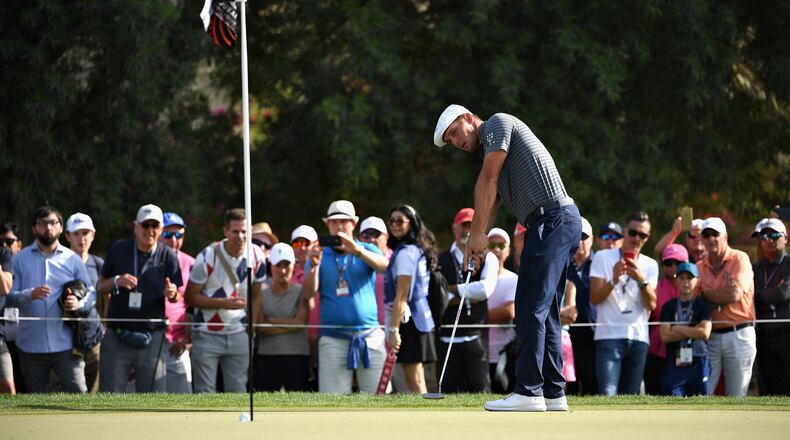Imagine: A hush falls over the gallery engulfing No. 18 in the dimming sun of a Masters Sunday, as Bryson DeChambeau surveys a tricky 15-foot putt that could spell victory.
As he hunches over the ball, and draws back his putter, there’s a look to the moment unlike any other in Masters lore. Something is off, not quite right. Wait, the flagstick still stands in the cup, as untended as a Peach Pass toll lane.
Surely the ghost of Bobby Jones will materialize in time to yank the flag and give this putt the same pure route to the hole as every other one since putters were made of hickory. But, no. Dead center, the ball rattles the stick and ...
Here we’ll leave the rest to your imagination, or perhaps your sense of decorum and tradition, as to whether that particular putt falls.
» Masters forecast: Wet, warm, azaleas
In his own mind’s eye, DeChambeau sees such a possibility and declares, “That would be cool, huh? That would be pretty historic.”
Various rule changes have taken effect in golf this year.
Some, like removing the penalty for accidentally moving a ball and allowing more freedom to repair damage on the green, certainly have lightened up some of the more severe rules of golf.
Some, like now dropping the ball from knee height rather than from shoulder height with arm extended, have caused some minor ripples. “I don’t think it looks proper or cool,” Rickie Fowler has said, “and people are making fun of it.”
But the untended-flagstick option is the one that has provoked the most conversation about its actual competitive and aesthetic impact. Yes, this is what passes for minor controversy in this sport.
All these rule changes make their major tournament debut Thursday at the most decorous, tradition-laden stop on the schedule, the Masters. It really is a semi-big deal at a place like Augusta National, because any little change in the look, the feel, the conduct of the game seems to be magnified here. This is not quite on the scale of introducing a T.I. song into “Guys and Dolls”, but you get the idea.
“Presently, I think it is (a bad look),” said Matt Kuchar, who played his first Masters in 1998 as an amateur from Georgia Tech. “Look down the line five years, 10 years, 20 years from now, maybe it’s a normal look. Now, it’s so new, it’s just awkward.”
There’s no easy age delineation here — it’s possible for the young to sound like the staunchest of traditionalists.
Where DeChambeau is a leader of the flagstick-in movement, his 25-year-old peer Justin Thomas would rather play in Birkenstock sandals than leave the flag in/untended while putting anywhere on the green.
“I mean if I have an 8-footer to win a golf tournament, I can't really take myself seriously if I kept the pin in,” Thomas said to begin this season.
“I mean,” he added, “it just would be such a weird picture on TV, me celebrating and the pin is in and my ball's like up against it.”
Thirty-six-year-old Francesco Molinari earned the distinction of becoming the first to sink a winning putt with the flagstick in — his 45-footer on the final hole of the Palmer Invitational was off the pin and in.
A veteran of 38 like Adam Scott, who has employed putters of all shapes and sizes to improve that part of his game — hang the appearances — believes there is an advantage to leaving in the flag that should be exploited.
A year ago, Scott was 165th on the PGA Tour in strokes gained putting. He is 17th thus far this season. “I don't know whether that's because the pin has helped me hole more putts,” he said during last month’s Players Championship. “It depends. For me I feel like on shorter putts when the pin is in I have a nice reference point of the exact middle of the hole and something to aim against. I'm not trying to hit putts harder and smash it into the pin. It's just more of a reference of aim.
“And as far as Augusta, I think it's a good thing, too. I mean, if it's working, I'll just keep doing it.”
Augusta National has given no indication that it would institute a local rule prohibiting the use of the flagstick while putting. It also has the option to switch to the slighter thicker type used at USGA events like the U.S. Open. That would discourage players leaving in the pin. But there have been no signals yet of such a change.
Thus far, only a small minority of players have chosen to use the flagstick while putting. There is no exact science to the benefit of the practice, although DeChambeau, the PGA Tour’s resident physicist, will start talking about aspects like terminal velocity and coefficient of restitution of the flagstick, and make it sound like a very good idea to use the pin.
Credit: Curtis Compton
Credit: Curtis Compton
But, he adds, “There is more than just the geometry to it; it’s the visual as well. The visual perspective. If you put a cup in the hole and it’s above the ground, you’ll hit that all day long, right? It’s much easier to have something out of the ground (aiming at that).”
Golfworld has cited a survey by Mike Shannon, a putting instructor at the PGA Tour’s Performance Center at the TPC Sawgrass, pointing to the mixed merits of putting with the pin in.
“Almost 70 percent of the players thought that keeping the pin in from outside of 10 feet gave that player better depth perception, which resulted in better speed and distance control,” Shannon told Golfworld. “But then inside of 10 feet, a majority of players felt that it actually made the cup look smaller, and they found they had a harder time with the shorter putts.”
A one-man survey of ESPN analyst Andy North indicates that making practical use of a flagstick this week makes perfect sense. "I think there's a bunch of putts at Augusta that you'll leave the flagstick in just because they are so fast that maybe you could get a little help," North said.
"I'm a big fan of leaving it in from 40, 50 feet from the hole. I think that can only help you. It helps your depth perception a little bit. But I don't understand leaving it in on 8-, 10- and 12-footers. I don't get that at all."
One certainty remains: No matter the unseemly look, 100 percent of all putts that drop at this year's Masters with flagstick still impaled through the heart of a perfect green will mean just as much as they always have.
About the Author
The Latest
Featured





